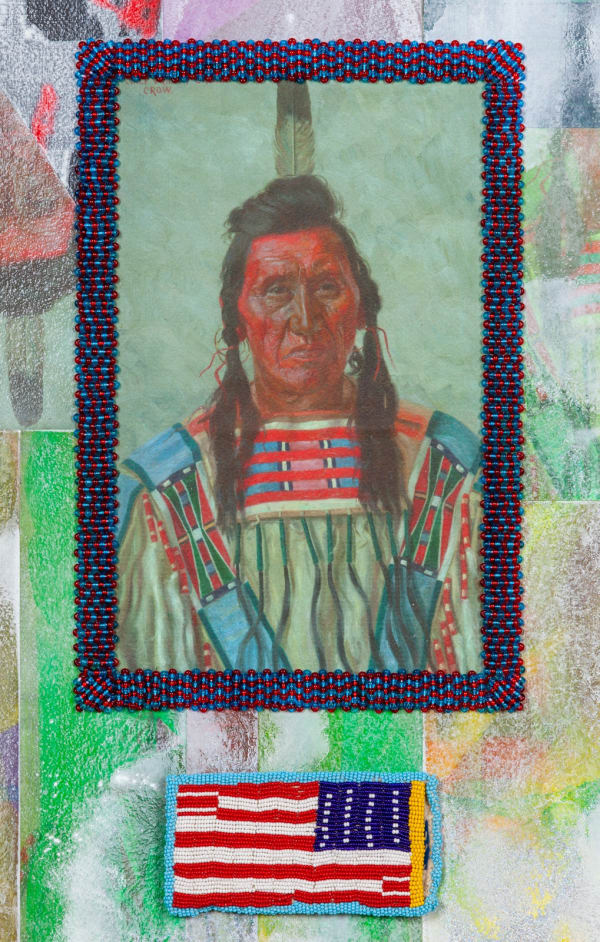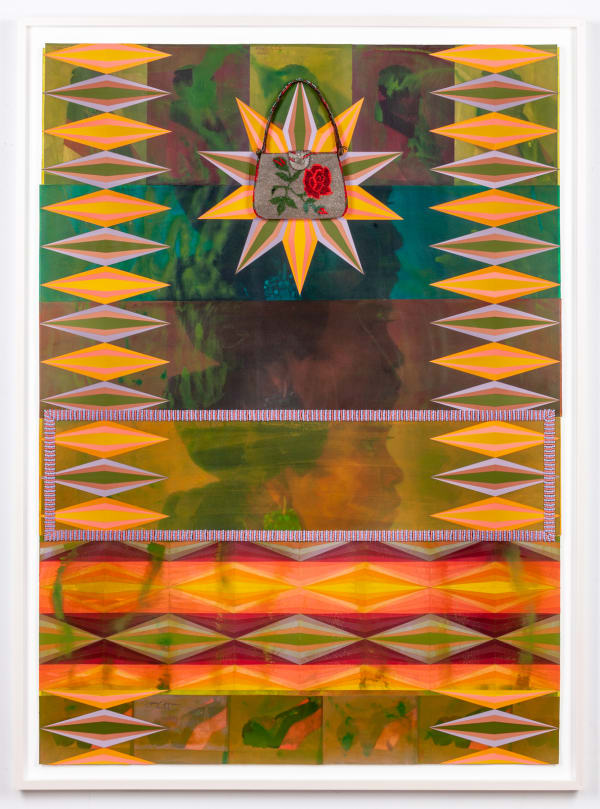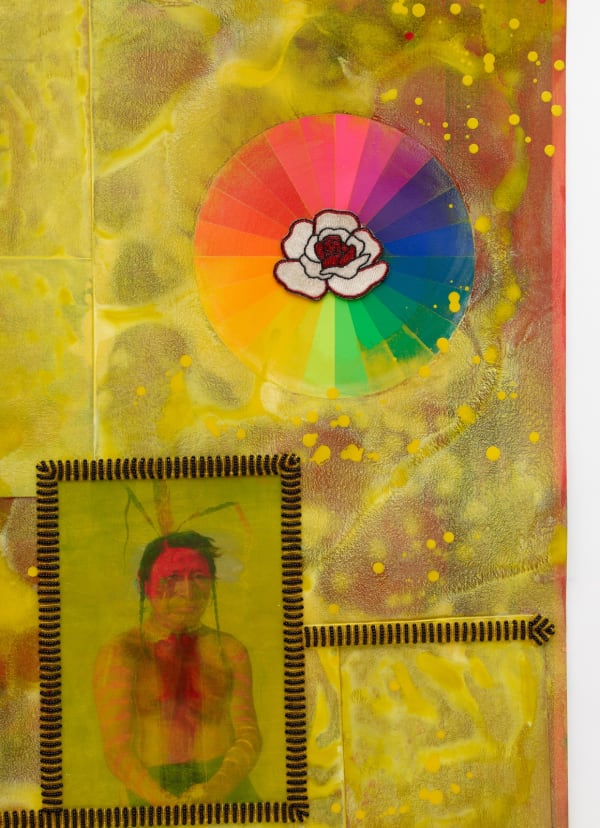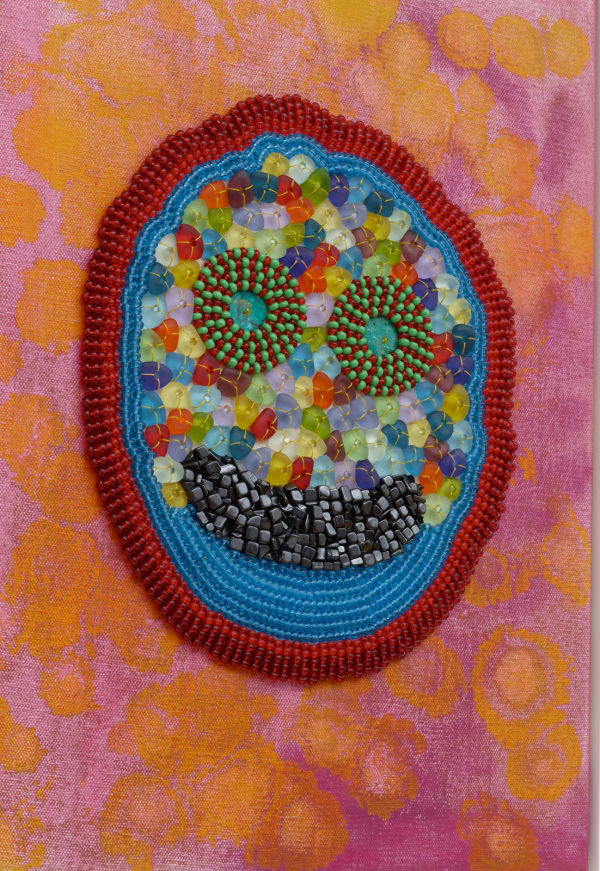-
-
Kavi Gupta presents Beyond the Horizon, a solo show of new works by Jeffrey Gibson, acclaimed visual artist and 2019 MacArthur Fellow.
Gibson’s aesthetic position is rooted in the spaces where narratives collide. The work recontextualizes relationships between popular culture, identity politics, personal experience, memory, and canonized ver-sions of history, inviting viewers to question the myths and assumptions that empower contemporary social structures.
For Beyond the Horizon, Gibson brings together four new bodies of work, integrating a broad mix of source content, including representations of, by, and about Indigenous people; literary tidings of cultural resist-ance and cooperation; and materials referencing multi-ple interlocking modernisms.
-
Meet the Artist: Jeffrey Gibson
Whitney Biennial 2019 -
-
Literally framing the exhibition is a large-scale wallpaper installation that incorporates drawings from the archives of the Field Museum in Chicago. Gibson was a research assistant at the museum in the early 1990s. There, he witnessed anthropologists debating the relative merits of an acquisition of contemporary artifacts from an Alaskan Indigenous community. Composed of such widely available consumer merchandise as diapers, toothpaste, tobacco, gloves, and mainstream candy products, the acquisition has yet to be put on view in the museum a generation later.
Would audiences protest if their weekend sojourn to a history museum consisted not of romanticized encounters with ancient artifacts, but with Sugar Daddies, Whoppers, Pepsi cans, and industrial sanitary products? Gibson’s luminous wallpaper celebrates the complexities of the question, providing a radiant visual and intellectual structure for an exhibition grounded in intertwined pasts and futures.
-
-
The unraveling of cultural and material themes continues in Gibson’s new series of Quilt Block Paintings. The pastiche appearance of these ambitious works is a material reflection of the intertextual narratives within. Says Gibson, “My grandmothers made quilts, and I collect quilts. I’m drawn to their patchwork quality. If you know where the fabrics are coming from, there’s a story that can be played out through material culture.”
Images of Indigenous people appear throughout the Quilt Block Paintings, interrogating differences between how Native Americans represent themselves and how they are represented by others. Ranging from the cartoonish, to the melodramatic, to the profane, these images draw attention to inherent biases within intercultural visual narratives, such as the tendency of non-Indigenous artists to attribute dark skin tones to their perceived foes and light skin to individuals, such as Pocahontas, whom they wish to convey as friendly to colonial concerns.
Also interwoven into many of the panels are delicate, beaded objects dating from the mid-19th to mid-20th centuries. Taken from Gibson’s private collection, these items were often made for personal reasons by their intended users, and other times made as “whimseys,” so-called because of their value to tourists as objects of wonder and amusement. Incorporating traditional and global materials, these beaded objects elucidate a crucial turning point more than a century and a half ago, when sudden access to global trade allowed Native American artists to expand their visual and material lexicon. Such moments amplify awareness of Modernism not as a one-time Western phenomenon, but a continuous and manifold spectrum.
-
-
-
In conversation with his Quilt Block Paintings, Gibson presents works from his new body of beaded bird sculptures, along with a selection of stunning mixed media paintings from a series he recently debuted in the exhibition Sweet Bitter Love at the Newberry Library in Chicago. The paintings continue Gibson’s investigation into the materials, artifacts, and images that cause people and cultures to become codified. Meanwhile, the beaded bird sculptures extend the notion of modernist multiplicities in various ways, including the use of globally sourced beads, and the bird’s anonymous form, which is more of an all-encom-passing representation of “birdness” than an attempt to convey a specific ornithological order.
-
-
-
Each work in Beyond the Horizon exemplifies Gibson’s deft ability to intermingle popular culture, literature, art history, memory, politics, myth, and material meaning. The source content he so insightfully remixes into new forms incites questions about whose representations of people and cultures should be validated; which memories and artifacts should be exalted; what creative products should be deemed to have constructive social value; and who decides. These works feel starkly orig-inal and idiosyncratic, but unified—a phenomenologi-cal manifestation of the complex, interwoven cultural fabrics that compete within our contemporary social space, and yet keep us stubbornly, inextricably bound.
-
Gibson (b.1972, USA) has exhibited his work extensively in many of the most influential cultural institutions in the world, and is represented in the permanent col-lections of more than twenty museums, including the Museum of Modern Art (MOMA), New York, NY; Denver Art Museum, Denver, CO; Museum of Fine Arts, Boston, MA; Philbrook Museum of Art, Tulsa, OK; Portland Museum of Art, Portland, ME; Portland Museum of Art, Portland, OR; High Museum of Art, Atlanta, GA; San Francisco Museum of Modern Art, San Francisco, CA; Seattle Art Museum, Seattle, WA; and Smithsonian American Art Museum, Washington, DC. A 2019 MacArthur Fellow, he holds an MA at the Royal College of Art, London, and a BFA from the School of the Art Institute of Chicago, and was awarded an Honorary Doctorate from Claremont Graduate University, Claremont, CA.







































